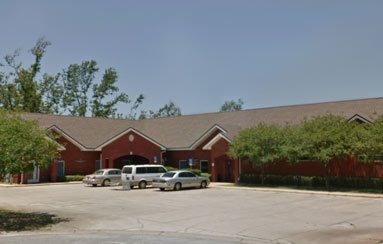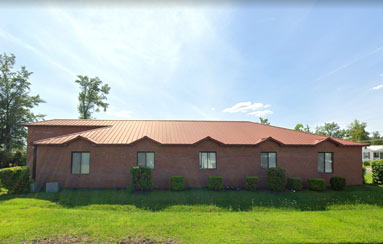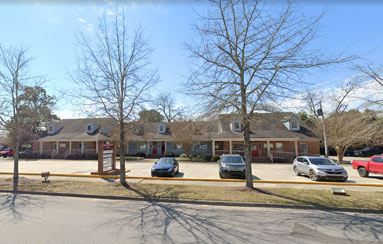COMMON DISORDERS & TREATMENTS
The physicians of Southern Vitreoretinal Associates treat Detached and Torn Retina Conditions with care and experience, utilizing the latest technologies and techniques.
Convenient Locations Throughout North Florida & South Georgia
What is a retinal detachment?
The retina is a nerve layer at the back of your eye that senses light and sends images to your brain. An eye is like a camera. The lens in the front of the eye focuses light onto the retina. You can think of the retina as the film that lines the back of a camera like wallpaper. The retina needs to be flattened against the back wall of the eye in order to function.
A retinal detachment occurs when the retina is pulled away from its normal position. The retina does not work when it is detached. A retinal detachment is a very serious problem that almost always causes blindness unless it is treated.
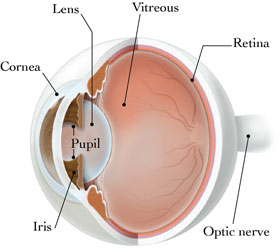
What causes a retinal detachment?
A clear gel called vitreous fills the inside of the eye. As we get older, the vitreous may pull away from its attachment to the retina at the back of the eye. Usually the vitreous separates from the retina without causing problems. But sometimes the vitreous pulls and tears the retina in one or more places. Fluid may pass through the retinal tear, lifting the retina off the back of the eye, like wallpaper peeling off a wall.
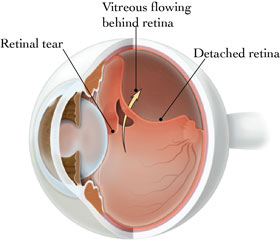
The following conditions increase the chance of having a retinal detachment:
- nearsightedness,
- previous cataract surgery,
- glaucoma,
- severe injury,
- previous retinal detachment in your other eye,
- family history of retinal detachment, and
- weak areas in your retina that can be seen by your ophthalmologist.
What are the warning symptoms of retinal detachment?
These early symptoms may indicate the presence of a retinal tear or detachment:
- flashing lights
- new floaters
- a shadow in the periphery of your field of vision
- a gray curtain moving across your field of vision
Although the presence of these symptoms is not always associated with a retinal detachment, they warrant an evaluation with an ophthalmologist as soon as possible. A careful dilated eye examination is needed in order to diagnose a retinal tear or retinal detachment.
What Treatment is Needed?
For Retinal Tears:
Most retinal tears need to be treated with laser surgery or cryotherapy (freezing), which seals the retina to the back wall of the eye. These treatments cause little or no discomfort and may be performed in your doctor’s office. Treatment usually prevents a retinal detachment.
For Retinal Detachment:
Most patients with retinal detachments require surgery to return the retina to its proper position.
Types of Surgery
There are several ways to repair a retinal detachment. The characteristics of your detachment will determine which type of surgery and anesthesia are needed.
In each of the following methods, your doctor will locate the retinal tears and use laser surgery or cryotherapy to seal the tear.
Scleral Buckle
This treatment involves placing a flexible band (scleral buckle) around the eye to counteract the force pulling the retina out of place and support the retinal tear from behind. The doctor often drains the fluid under the detached retina, allowing the retina to settle back into its normal position against the back wall of the eye. This procedure is performed in an operating room.
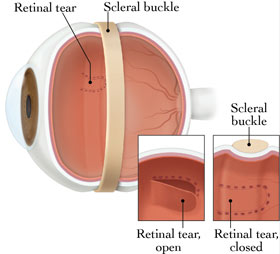
Pneumatic Retinopexy
In this procedure, a gas bubble is injected into the vitreous space inside the eye. The gas bubble pushes the retinal tear closed against the back wall of the eye. Your doctor will ask you to maintain a certain head position for several days.
The gas bubble will gradually disappear. Sometimes this procedure can be done in the doctor’s office.
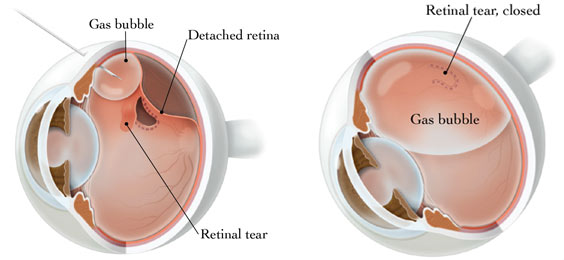
Vitrectomy
The vitreous gel, which is pulling on the retina, is removed from the eye and usually replaced with a gas bubble.
Your body’s own fluids will gradually replace the gas bubble. Sometimes vitrectomy is combined with a scleral buckle.
After Surgery
Flashing lights and floaters may continue for a while after surgery. If a gas bubble was placed in your eye, your doctor may recommend that you keep your head in special positions for a time.
*DO NOT FLY in an airplane or travel at high altitudes until you are told the gas bubble is gone. A rapid increase in altitude can cause a dangerous rise in eye pressure. Most retinal detachments can be repaired/ flattened with one operation. Recurrent retinal detachments, although rare (<10%), can occur if scar tissue forms after retinal reattachment surgery and another retinal tear is made.
What are the Risks of Surgery?
Any surgery has risks; however, an untreated retinal detachment usually results in permanent severe vision loss or blindness.
Some of the surgical risks of retinal detachment surgery include:
- infection
- bleeding
- high pressure in the eye
- cataract
Most retinal detachment surgery is successful, although a second operation is sometimes needed.
If the retina cannot be reattached, the eye will continue to lose sight and ultimately become blind.
Will your vision improve?
Vision may take many months to improve and in some cases may never return fully. Unfortunately, some patients do not recover any vision. The more severe the detachment, the less fully the vision may return. For this reason, it is very important to see your ophthalmologist at the first sign of any trouble.
Your retinal surgeon or their staff can answer any questions you may have concerning retinal tears and detachment.
Visit one of our primary offices in Tallahassee, FL or Valdosta, GA
SOUTHERN VITREORETINAL ASSOCIATES
The Most Advanced Retina Care
Delivering the highest-quality retina care by providing our patients access to the best and newest retina treatments available, along with the quality of care that we would want for our family members.


